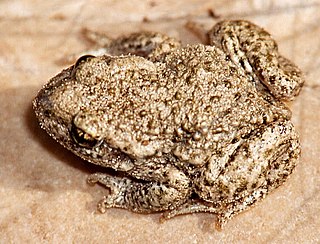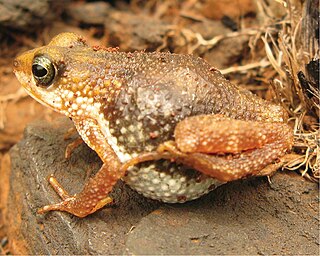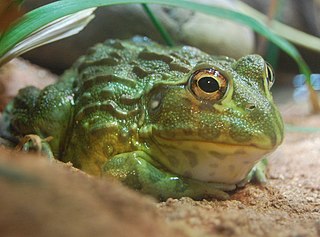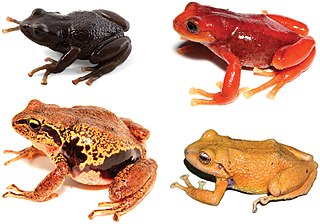
The Alytidae are a family of primitive frogs. Their common name is painted frogs or midwife toads. Most are endemic to Europe, but there are also three species in northwest Africa, and a species formerly thought to be extinct in Israel.

Megophryidae, commonly known as goose frogs, is a large family of frogs native to the warm southeast of Asia, from the Himalayan foothills eastwards, south to Indonesia and the Greater Sunda Islands in Maritime Southeast Asia, and extending to the Philippines. Fossil remains are also known from North America. As of 2014 it encompasses 246 species of frogs divided between five genera. For lack of a better vernacular name, they are commonly called megophryids.

The Rhinophrynidae are a family of frogs containing one extant genus, the monotypic Rhinophrynus, and a number of fossil genera. The family is sometimes known as the Mexican burrowing toads or simply burrowing toads.

A true toad is any member of the family Bufonidae, in the order Anura. This is the only family of anurans in which all members are known as toads, although some may be called frogs. The bufonids now comprise more than 35 genera, Bufo being the best known.

Nectophrynoides is a genus of true toads, family Bufonidae. They are endemic to Eastern Arc forests and wetlands in Tanzania, and all except N. tornieri are threatened. Species of the genus are ovoviviparous: fertilization is internal, and the females give birth to fully developed, small toadlets. Together with the West Africa Nimbaphrynoides and Limnonectes larvaepartus, they are the only frogs/toads in the world that do not lay eggs. The Ethiopian Altiphrynoides, which lay eggs, were also part of Nectophrynoides in the past.
Churamiti is a genus of toads endemic to Tanzania. It is monotypic and represented by a single species, Churamiti maridadi. This species is only known from its type locality in the Mamiwa-Kisara Forest Reserve in the Ukaguru Mountains. Only four specimens are known. The scientific name is derived from the Swahili words chura meaning toad or frog, miti meaning tree, and maridadi meaning beautiful, for the descriptive "beautiful tree-toad".

Nectophrynoides poyntoni, also known as Poynton's forest toad, is a species of toad in the family Bufonidae. It is endemic to the Udzungwa Mountains in Tanzania and is only known from its type locality in the Mkalazi Valley. This species is only known from a single collection in 2003 and has not been seen ever since, despite targeted searches. Therefore, it is feared that it has strongly declined and might already be extinct.
Nectophrynoides wendyae, also known as the Uzungwe Scarp tree toad or Wendy's forest toad, is a terrestrial toad in the family Bufonidae. It is endemic to Tanzania and is only known from a single valley in the Udzungwa Mountains. The specific name wendyae honours Wendy Clarke, the describer's wife.
Malcolm's Ethiopian toad or the Ethiopian mountain toad, Altiphrynoides malcolmi, is a species of toad in the family Bufonidae endemic to the Bale Mountains of Ethiopia. Its natural habitats are Schefflera-Hagenia-Hypericum forests and Afro-alpine moorland, and the transition zone in between. It is threatened by habitat loss and is listed by the IUCN as being an "endangered species".
Nectophrynoides pseudotornieri is a species of toad in the family Bufonidae. It is endemic to the Uluguru Mountains in eastern Tanzania. Common names pseudo forest toad and false Tornier's viviparous toad have been proposed for it. Its specific name refers to its similarity to Nectophrynoides tornieri.
Nectophrynoides tornieri, Tornier's forest toad or kijula, is a species of toad in the family Bufonidae. It is endemic to Tanzania. This species was first described by Jean Roux in 1906 and was named in honour of the German zoologist Gustav Tornier.
Nectophrynoides vestergaardi, also known as the Vestergaard's forest toad, is a species of toad in the family Bufonidae. It is endemic to the West Usambara Mountains, Tanzania. It is named in honour of Martin Vestergaard, the Danish biologist who was the first to recognize that the population now described as Nectophrynoides vestergaardi was a new species.
Nectophrynoides viviparus is a species of toad in the family Bufonidae. It is endemic to Tanzania. Common names robust forest toad and Morogoro tree toad have been coined for it.
Osgood's Ethiopian toad is a possibly extinct species of toad in the family Bufonidae endemic to the mountains of south-central Ethiopia. It was named for the American biologist Wilfred Hudson Osgood who carried out fieldwork in Ethiopia for the Field Museum in 1926–27. He collected the original specimens of Osgood's Ethiopian toad and three other endemic species of anuran.
Sylvacaecilia is a monotypic genus of caecilian. The only species is Sylvacaecilia grandisonae, also known as the Aleku caecilian or Ethiopian caecilian. It is endemic to southwestern Ethiopia and known from the Gambela, Oromia, and Southern Nations, Nationalities, and Peoples' Regions.

Nimbaphrynoides is a monotypic genus of true toads from highlands in the Mount Nimba region of the West African countries of Guinea, Liberia, and Côte d'Ivoire. The sole species is Nimbaphrynoides occidentalis. Along with Nectophrynoides, Eleutherodactylus jasperi, and Limnonectes larvaepartus, Nimbaphrynoides is one of the only anurans that combine internal fertilization with ovoviparity.

The Pyxicephalidae are a family of frogs found in sub-Saharan Africa.

The Craugastoridae, or fleshbelly frogs, are a family of New World direct-developing frogs. As delineated here, following the Amphibian Species of the World, it is a large family containing 857 species. They are found from the southern United States southwards to Central and South America.
Sabahphrynus is a monotypic genus of amphibians in the family Bufonidae. The sole species is Sabahphrynus maculatus, also known as the spotted Asian tree toad or Sabah earless toad. It is endemic to Borneo where it is only known from Sabah, East Malaysia.








